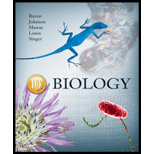
Concept explainers
Which of the following statements is NOT part of the cell theory?
a. All organisms are composed of one or more cells.
b. Cells come from other cells by division.
c. Cells are the smallest living things.
d. Eukaryotic cells have evolved from prokaryotic cells.
Introduction:
The cell theory explains that all the living organisms are composed of cells and cells are the basic unit of life. The cell theory was proposed by German botanist Matthias Schleiden and German physiologist Theodor Schwann. They observed that all plant and animal tissues consists of aggregates of individual cells, which are separate and independent units. These individual units were cells and thus, the cell theory was proposed.
Answer to Problem 1U
Correct answer:
The cell theory explains that all the living organisms are composed of one or more cells, which are the smallest living things, and cells arise from preexisting cells by cell division. Therefore, option d is the correct answer.
Explanation of Solution
Reason for the correct statement:
The cell theory includes three principles: all the living organisms are composed of one or more cells, cells are the smallest living things and cells arise from other cells by the process of cell division.
Option d is given as “Eukaryotic cells have evolved from prokaryotic cells.”
As, the statement “eukaryotic cells have evolved from prokaryotic cells” is not a part of the cell theory, it is the right answer.
Hence option d is correct.
Reasons for the incorrect statements:
Option a is given as “All organisms are composed of one or more cells.”
The cell theory explains the observations that all living organisms are made up of one or more cells. This statement is one of the principles included in the cell theory. So, it is a wrong answer.
Option b is given as “Cells come from other cells by division.”
The cells increase in their number by the process of cell division by which the new cells arise from pre-existing cells. This statement is also one of the principles included in the cell theory. So, it is a wrong answer.
Option c is given as “Cells are the smallest living things.”
All living organisms like plant and animal tissues consist of aggregates of individual cells, which are separate and independent units. These units are called cells, which are the smallest living things. This statement is also one of the principles included in the cell theory. So, it is a wrong answer.
Hence options a, b, and c are incorrect.
The cell theory is a basic principle of biology that explains about the basic functional and structural unit of life called a cell.
Want to see more full solutions like this?
Chapter 4 Solutions
Biology
- The following table is from Kumar et. al. Highly Selective Dopamine D3 Receptor (DR) Antagonists and Partial Agonists Based on Eticlopride and the D3R Crystal Structure: New Leads for Opioid Dependence Treatment. J. Med Chem 2016.arrow_forwardThe following figure is from Caterina et al. The capsaicin receptor: a heat activated ion channel in the pain pathway. Nature, 1997. Black boxes indicate capsaicin, white circles indicate resinferatoxin. You are a chef in a fancy new science-themed restaurant. You have a recipe that calls for 1 teaspoon of resinferatoxin, but you feel uncomfortable serving foods with "toxins" in them. How much capsaicin could you substitute instead?arrow_forwardWhat protein is necessary for packaging acetylcholine into synaptic vesicles?arrow_forward
- 1. Match each vocabulary term to its best descriptor A. affinity B. efficacy C. inert D. mimic E. how drugs move through body F. how drugs bind Kd Bmax Agonist Antagonist Pharmacokinetics Pharmacodynamicsarrow_forward50 mg dose of a drug is given orally to a patient. The bioavailability of the drug is 0.2. What is the volume of distribution of the drug if the plasma concentration is 1 mg/L? Be sure to provide units.arrow_forwardDetermine Kd and Bmax from the following Scatchard plot. Make sure to include units.arrow_forward
- Choose a catecholamine neurotransmitter and describe/draw the components of the synapse important for its signaling including synthesis, packaging into vesicles, receptors, transporters/degradative enzymes. Describe 2 drugs that can act on this system.arrow_forwardThe following figure is from Caterina et al. The capsaicin receptor: a heat activated ion channel in the pain pathway. Nature, 1997. Black boxes indicate capsaicin, white circles indicate resinferatoxin. a) Which has a higher potency? b) Which is has a higher efficacy? c) What is the approximate Kd of capsaicin in uM? (you can round to the nearest power of 10)arrow_forwardWhat is the rate-limiting-step for serotonin synthesis?arrow_forward

 Biology Today and Tomorrow without Physiology (Mi...BiologyISBN:9781305117396Author:Cecie Starr, Christine Evers, Lisa StarrPublisher:Cengage Learning
Biology Today and Tomorrow without Physiology (Mi...BiologyISBN:9781305117396Author:Cecie Starr, Christine Evers, Lisa StarrPublisher:Cengage Learning Concepts of BiologyBiologyISBN:9781938168116Author:Samantha Fowler, Rebecca Roush, James WisePublisher:OpenStax College
Concepts of BiologyBiologyISBN:9781938168116Author:Samantha Fowler, Rebecca Roush, James WisePublisher:OpenStax College





